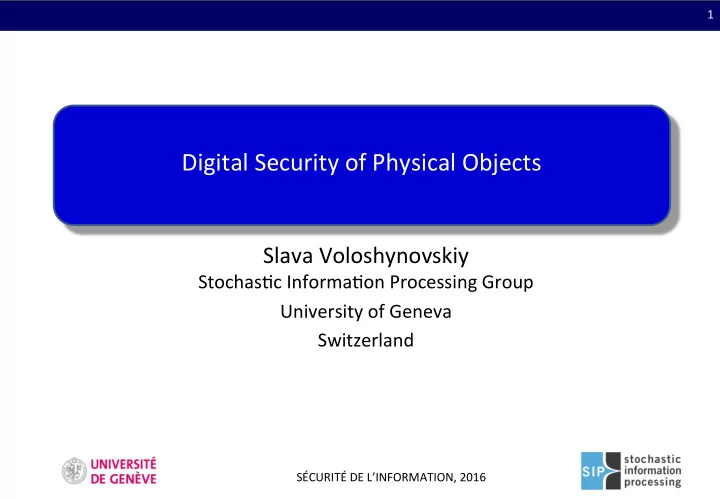

1 Digital Security of Physical Objects Slava Voloshynovskiy Stochas:c Informa:on Processing Group University of Geneva Switzerland SÉCURITÉ DE L’INFORMATION, 2016
2 Outline Physical object security Why not tradi:onal security? Proposed solu:ons for Object recogni:on Design verifica:on Physical uncloneable func:ons Conclusions
3 SIP group at glance Basic facts: Founded in 1998 Currently 8 people Group produced 10 PhDs Main background: Technology valoriza7on: Sta:s:cal image processing 6 licensed patent families Informa:on theory 3 spin-offs Machine learning Exper7se in: Digital watermarking 2015 DCT ! Fingerprin:ng 2003 1999 Physical object security
4 1. Physical object security Humans = biometrics Physical Objects Watches Packaging Electronics All physical objects are unique like humans Main security concerns Why security is important? § Authen:city § Damage of brand reputa:on § Origin (iden:fica:on) § Loss of profit § Ownership § Danger for life § Track and trace § …..
5 2. Why not “tradi:onal” security Main restric7on of exis7ng security technologies for physical objects: § Proprietary technologies (rare or expensive materials, inks, holograms, etc.) § obsolete and easy to clone by modern means § expensive for mass markets § special equipment or special knowledge of original features are required § Crypto security § not directly applicable to noisy data § very sensi:ve to light and geometrical varia:ons § RFID/Connected devices/Internet of Things § s:ll quite expensive § serious security wholes
6 2. Why not “tradi:onal” security Requirements to modern physical object security: § easy to verify authen7city but difficult to clone o cloning should economically inefficient § non-proprietary: based on physical-crypto principles o protec:on mechanism is assumed to be public § no special equipment required o preferably on mobile phone (in possession of everyone) § no special training required o any user can validate it § cheap and scalable to mass markets o millions or billions of products § non-invasive o products and produc:on should not be modified
7 3. Product security: a framework Individual Object Design object recogni:on verifica:on iden:fica:on Micro features Micro features Typical object of design of carrier (PUFs) features Three levels of security: § Object recogni:on § Printed/reproduced visible features typical for all object of the same category
8 3. Product security: a framework Individual Object Design object recogni:on verifica:on iden:fica:on Micro features Micro features Typical object of design of carrier (PUFs) features Three levels of security: § Object recogni:on § Printed/reproduced visible features typical for all object of the same category § Design verifica:on § Features of probe are verified wrt features of original template
9 3. Product security: a framework Individual Object Design object recogni:on verifica:on iden:fica:on Micro features Micro features Typical object of design of carrier (PUFs) features Three levels of security: § Object recogni:on § Printed/reproduced visible features typical for all object of the same category § Design verifica:on = digital forensics § Features of probe are verified wrt features of original template § Individual object iden:fica:on § Features of probe carrier are tested wrt features of enrolled PUFs
10 3.1. Stage 1: object recogni:on Main specs to object recogni7on: § Mobile phones § Very accurate § Fast and scalable to millions § Invariant to observa:on condi:ons such as light, geometry, etc Experimental dataset Enrollment system
11 3.1. Stage 1: object recogni:on ( universal SketchPrint descriptor) Main steps of SketchPrint: key-points detec:on • SketchPrints extrac:on and filtering • aggrega:on of many SketchPrint descriptors into one super-vector •
12 3. Stage 1: object recogni:on ( universal SketchPrint descriptor) ) Performance and comparison to SOTA 0 10 SIFT − 1 10 ORB Sketchprint − 2 10 − 3 10 − 4 P F 10 − 5 10 − 6 10 − 7 10 − 8 10 − 4 − 3 − 2 − 1 0 10 10 10 10 10 P M Remark Remarks § SketchPrint considerably outperforms both SIFT and ORB § smaller number of descriptors per image less memory ⇒
13 3.2. Stage 2: design verifica:on Given : a package Ques7on: • Is this package authen:c? Remark : you have never seen it or remember its design roughly… Your thinking: well....quality of print looks OK ......logo seems OK ........I buy it from a reputable vendor (incl web) .............. so probably authen7c!
14 3.2. Stage 2: design verifica:on Observa7on: if we know the original design, we can easily verify its authen:city. Ques7on: • Can we perform the design verifica:on automa:cally? • And how accurately (say with the precision about 10-15 microns)?
15 3.2. Stage 2: Automa:c design verifica:on on mobile phones 5’000 printed object s Modified text
16 3.2. Stage 2: Automa:c design verifica:on on mobile phones Authen:c Text Graphics Images Microstructures Watches Photos Not authen:c 15 micrometers
17 3.3. Stage 3: individual object recogni:on • Ques7on: can we differen7ate each individual object? Paper microstructures =PUFs Package 1 Individually unique PUFs Package 2 . . . Package M Visibly packages look iden:cal
18 2. Stage 3: individual object recogni:on • Open issue: Big Data (millions of objects with high-dimensional features) Defini:on (Digital content fingerprin:ng) Digital content fingerprin:ng (a.k.a. robust perceptual hashing) is a technique for compu:ng a compact robust, secure and private binary representa:on of image. Binary Symmetric Channel (BSC) 0 0 1 1
19 3.3. Stage 3: individual object recogni:on Proper:es Correct acceptance Correct rejec:on Hypothesis tes:ng Binomial distribu:on Binomial distribu:on
20 3.3. Stage 3: individual object recogni:on • Fast search Hamming sphere decoding Observa:on: the most likely codewords are within a Hamming sphere with radius around . Iden:fica:on = codeword presence verifica:on Hamming sphere Data user Codebook/Database Server P L § b b y 1 Fingerprint Y/N query 2 M
21 4. Conclusion • Physical object security = mul7disciplinary research field covering: • Image processing • Computer vision • PUFs • Crypto • Big Data • Physical object security is of: • great interest for industry and especially for the Swiss industry (protec:on of Swiss brands) • great significance for end users • Demos aZer presenta7on slot
Recommend
More recommend